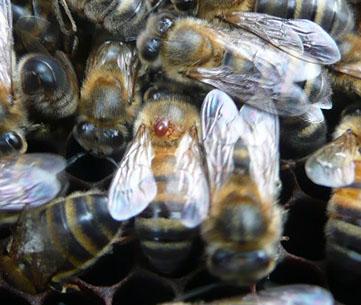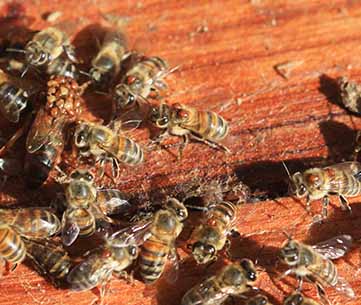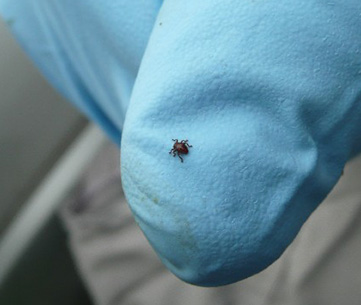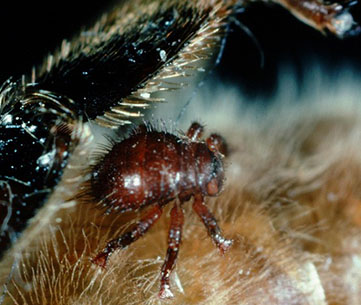
The Braula fly (Braula coeca) is a small species of wingless fly that lives in honey bee colonies. The Braula fly is not considered to be a serious threat to commercial beekeeping as it does not damage or parasitise any stage of the honey bee life cycle. Instead, it is considered to be a minor pest as the Braula fly larvae damage the appearance of the wax cappings on honey comb and adult Braula flies steal small amounts of food from adult honey bees.
The Braula fly is currently widespread overseas and has been reported from all continents. In Australia it is only known to occur in Tasmania. In mainland Australia, Braula fly has been found in Victoria but remains a reportable pest.

Braula fly on the thorax of a worker honey bee. The Food and Environment Research Agency (Fera), Crown Copyright
The following is a summary of the life cycle of Braula flies:
Braula flies take between 10 and 21 days to develop from eggs to adults. The time required is dependent on temperature. Braula flies are able to survive in the absence of brood but require the presence of adult honey bees to survive. Adult Braula flies are thought to overwinter on adult honey bees. After conditions have become favourable again the females lay eggs and the life cycle continues.

Numerous Braula flies on the thorax of a queen bee. Lindsay Bourke
The Braula fly is a small (0.9 mm wide by 1.5 mm long) wingless fly. It is red-brown coloured, covered in hairs and has six legs, which look large in relation to its body size. Braula fly lay small white eggs (0.84 mm by 0.42 mm) throughout the hive, however, only the eggs deposited on capped honey comb will hatch. Adult Braula flies can be seen on workers, drones and queens, but have a recognised preference for queen bees. In some cases queens can carry a large number of Braula fly, each of which steals a small amount of food from the queen. If enough Braula flies are present this can cause the queen to lay fewer eggs and possibly cause her supersedure.

Fractured honey comb from burrowing Braula fly larvae. NSW DPI
Regular inspection of queens is a good way to detect the pest. The larvae tunnel under the cappings leaving narrow tracks about 1 mm wide, which are visible across the surface of the comb. This tunnelling gives the comb a cracked or fractured appearance, which is a key characteristic of Braula fly infestation. It is this damage that has the greatest impact on specialist comb honey producers.

Braula flies on worker bees and numerous Braula flies on the queen bee. Ben Oldroyd, University of Sydney
Adult Braula flies are small (0.9 mm wide by 1.5 mm long), wingless, red-brown flies which can be seen riding on the thorax or abdomen of adult honey bees. Braula flies prefer queen bees but will also climb onto drones and worker bees. As a result of this preference, queen bees should be thoroughly and regularly checked for the presence of Braula fly.
Damage caused by the larvae is easily observed on infested honey combs. While feeding, Braula fly larvae create a narrow (approximately 1 mm wide) tunnel under the wax cappings. These tunnels are visible on the surface of the honey comb and give the comb a cracked or fractured appearance. It is this damage that affects the appearance and marketability of any comb honey produced.
For more information about detection methods click on the below links:

Close up view of fractured appearance of honey comb from burrowing Braula fly larvae. NSW DPI
Braula fly is present in Tasmania and Victoria but it is a reportable pest in mainland Australia. If you live outside of Tasmania and notice Braula fly on your bees you should immediately report it to your local department of agriculture or call the Exotic Plant Pest Hotline on 1800 084 881.

Size of Braula fly on a finger. The Food and Environment Research Agency (Fera), Crown Copyright
Braula fly lack wings but can be easily spread between colonies through the natural behaviour of honey bees, such as drifting, absconding or swarming, and through the movement of hives and honey bee products by beekeepers.
Adult Braula fly and Braula fly larvae can easily be spread through the movement of hives, as well as honey bee products, such as honey comb. This will quickly spread Braula fly amongst the apiary.
There is also a potential for queen bees and package bees to spread adult Braula fly over large distances. Buying healthy queen and package bees from reputable sources will help reduce the risk of spreading Braula fly by this pathway.
Braula flies are able to be spread through the natural behaviour of honey bees. Adult Braula flies attach themselves to adult bees, which provide a source of food and transport. Robber bees, drifting, swarming and absconding colonies can all spread Braula fly amongst an apiary, or to a new region. Once in a new colony female Braula flies lay eggs and a new infestation can occur.

Close up of Braula fly on a honey bee. The Food and Environment Research Agency (Fera), Crown Copyright
Braula fly is thought to be native to Europe. It has since spread around the world with the movement of bees and now occurs in Asia, North America, South America and Africa.
In Australia Braula flies are found in Tasmania and Victoria.

Close up of Braula fly on a honey bee. The Food and Environment Research Agency (Fera), Crown Copyright
Braula fly is a small (0.9 mm wide by 1.5 mm long), wingless, red-brown fly that is carried on adult honey bees. It is a similar size and colour to the exotic Varroa mites (Varroa destructor and V. jacobsoni) and Tropilaelaps mites (Tropilaelaps clareae and T. mercedesae), and has a similar habit of attaching itself to adult honey bees. Braula fly is also similar to the endemic Pollen mite (Mellitiphis alvearius). These similarities mean that these species can be confused with each other.
The following is a description of each of the similar pests that Braula fly could be confused with.

Braula fly (top), Varroa mite (right), Tropilaelaps mite (bottom) and Pollen mite (left). Food and Environment Research Agency (Fera), Crown Copyright
The presence of lines created by Braula fly larvae on the wax cappings of combs and the physical size of the adult should help to separate these species. However if you are unsure please contact your state or territory department of agriculture for further advice.
Braula fly is a reportable pest in states and territories except for Tasmania . Varroa mites and Tropilaelaps mites are reportable pests in all Australian states and territories. For more information about these pests, please see their respective pest pages.
If you live outside of Tasmania and notice Braula fly on your bees you should report it immediately to your local department of agriculture or call the Exotic Plant Pest Hotline immediately on 1800 084 881.
Braula fly is present in Tasmania and Victoria, but is not present anywhere else in Australia.
Generally, Braula fly is not a significant pest of honey bees. In most cases control is not required as Braula fly doesn’t have a significant impact on the colony’s health or honey yields. However, beekeepers specialising in comb honey production may need to consider control measures if Braula fly is present in high numbers during peak production periods. This is because the tunnelling of Braula fly larvae affects the appearance and marketability of honey comb.
Some simple management options exist that can control the impact of Braula fly, these include:
Additional fact sheets from Australia and from around the world, which provide extensive information about this pest, have been listed below. To learn more, click on the links below:
Braula fly, Plant Health Australia
Braula fly, NSW DPI
Braula fly, University of Florida
Australian Beekeeping Guide (2014) Agrifutures Publication No. 14/098
These videos provide information about the life cycle and biology, identification and possible management options for Braula fly. Please be aware that some were produced overseas, and treatment recommendations or conditions experienced may differ to those in Australia.
Alcohol washing, Plant Health Australia |
Sugar shaking, NSW DPI and Tocal Agricultural College |